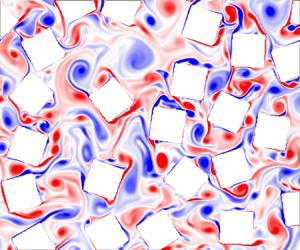No CrossRef data available.
Article contents
Extended Darcy–Forchheimer law including inertial flow deflection effects
Published online by Cambridge University Press: 31 January 2024
Abstract

Recent advances in manufacturing techniques are providing porous media with both high permeability, necessary for effective passive flow control, and high structural strength, essential for engineering applications. We therefore examine the predictive accuracy of the standard Darcy–Forchheimer (DF) law, which is often used to model porous media flows, for inclusion Reynolds numbers (Re) ranging from the low linear regime to the high nonlinear regime where unsteady effects such as vortex shedding become evident. We consider two different inclusion shapes, square and circular, and three different arrangements of the inclusions – inline, staggered and random. The numerical simulations show that the DF law performs well for low-Re flows, irrespective of the inclusion configuration. For intermediate/high-Re flows, the DF law is adequate only when the arrangement is highly random. However, for the regularly arranged topologies or less random geometries at intermediate/high-Re flows, the DF-law performance diminishes significantly due to flow sheltering and redirection (‘inertial flow deflection’) effects that arise from flow inertia, separation and vortex shedding in the wake of the inclusions. It is shown that the standard DF law, in which the nonlinear permeability tensor is independent of orientation, does not capture such effects. We modified the DF law to capture flow redirection effects by allowing the Forchheimer permeability tensor to depend on the flow orientation with respect to the principal geometrical directions of the porous geometry, and examined this extended DF law for these flows.
JFM classification
- Type
- JFM Papers
- Information
- Copyright
- © The Author(s), 2024. Published by Cambridge University Press





